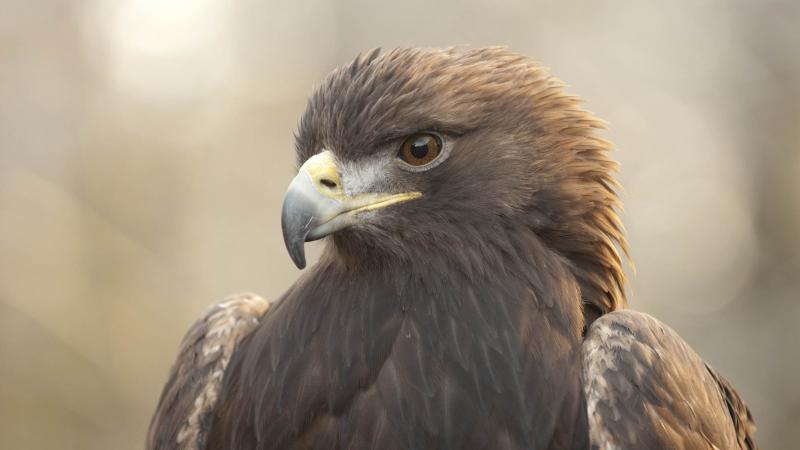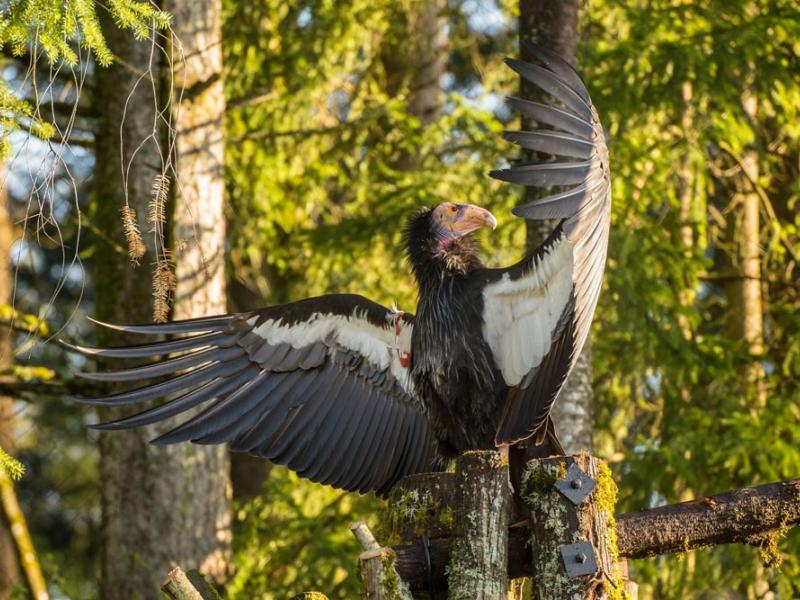
Golden eagles are found in Europe, Asia, North Africa, the Arabian Peninsula and North America. They range from sea level to 10,000 feet in many habitats: forests, tundra, prairies, sagebrush, scrubland or alpine meadows. They are probably the most numerous of large eagles in the world. In North America, golden eagles are more common west of the Mississippi River. Like all raptors, they are carnivores.
Did you know?
- Aquila means eagle in Latin. Some people are said to have an aquiline nose; this means their nose is curved like an eagle's beak.
- At the center of the Mexican flag, a golden eagle sits on a prickly pear cactus, eating a snake.
- During the Middle Ages in Europe when falconry (hunting with birds) was popular, the golden eagle was reserved for the emperor's sole use. The founder of the Mongol empire, Genghis Kahn (1167-1227), used golden eagles to attack enemies in battle.
Golden eagle plumage and color
- Plumage is dark brown with golden feathers at the back of the head and neck. Legs are feathered to yellow feet. The beak is bluish-black with a yellow cere (a membrane at the base of the upper beak). Wings are broad and the tail is rounded. Eyes are brown.
- Juveniles are similar but with whitish areas at the base of the flight (primary) feathers. These can be seen when the bird is in flight. The tail is two-thirds white with a broad black band at the end. Each annual molt diminishes the white until at maturity (about five years) it disappears. Eyes are a darker brown.
- Golden eagles are sometimes mistaken for an immature bald eagle. The feathered lower legs, slightly larger wingspan and smaller beak can distinguish them.
Golden eagle behavior and facts
- Golden eagles prey on small mammals, birds, reptiles and jackrabbits, with mammals comprising more than 70 percent of their diet. They may also eat carrion. When game birds are abundant, eagles prey on them.
- They use their soaring ability and keen eyesight to locate prey. After spotting it, they dive at speeds up to 120 mph and seize the prey with their feet and talons. Most prey is taken on the ground, but large birds such as goose, crane or diving ducks may be struck in the air.
- A pair of golden eagles occupies a territory size that depends on available prey. For instance, in Scotland they require 11,000 to 18,000 acres; in California, 19 to 59 square miles. In the Northeastern United States, the territory may be up to 200 square miles, but only a small portion of that may provide suitable prey habitat.
- Populations from northern areas migrate south in winter; eagles from more temperate climates remain year round.
- Courtship displays and mating behaviors may be seen in almost any month. Aerial displays are commonly seen between mated pairs, including undulating flights involving a complex series of dives and swoops. The pair may also soar together, and the male will dive toward the female who turns on her back and presents her talons to his.
From birth to death
- Mating: year-round.
- Nests are built on rocky cliffs or in tall trees. Eagles may reuse and enlarge their nest each year; nests on cliff ledges can be up to eight feet in diameter and three to four feet thick. Tree nests are usually deeper and more massive. The largest recorded nest: 17 feet deep and four feet across.
- One to four eggs – most commonly two – are laid in March at three- to four-day intervals. Eggs are dull white with brown blotches.
- Incubation: five to six weeks, mostly by the female.
- Chicks hatch at intervals over several days. If food is scarce and there is more than one chick, competition between siblings can be fierce and typically only the oldest will survive.
- For the first 14 days, both parents tend the chicks, although males are more likely to be hunting while the females guard the nest. During this time, the parents tear off and feed small bits of raw meat to the chicks.
- Golden eagles may fledge (begin flying) at around 10 weeks, although the parents may continue to provide food for the young for 14 weeks or more.
- Sexual maturity: four to five years
- Lifespan: 15 to 20 years in the wild; in captivity, golden eagles have lived to 68 years.
Vital statistics
- Females: 32 to 40 inches long, 8 to 14 pounds with a wingspan of 6 to 7 feet
- Males: 30-35 inches long, 5 to 9 pounds, with a wingspan of 5 to 6 feet
Status
Golden eagles are protected in the United States by the Migratory Bird Treaty Act, and also the Bald and Golden Eagle Act. They were once considered extinct east of the Mississippi River, although they are now locally common in much of the United States.
Golden eagles, the Oregon Zoo and you
The zoo's golden eagle, Deschutes, is part of the Wild Life Live! shows. Deschutes was received by the Oregon Department of Fish and Wildlife in Hines, Ore., on July 22, 2004. He had been found alongside a road with a head trauma after being hit by a vehicle. The accident resulted in blindness in his right eye, but there were no other injuries. Because Deschutes is blind in one eye, it was determined with the lack of depth perception would prevent him from hunting successfully.
You can help golden eagles continue to thrive in their range by joining a conservation organization that works to protect eagle habitat such as The Nature Conservancy.




